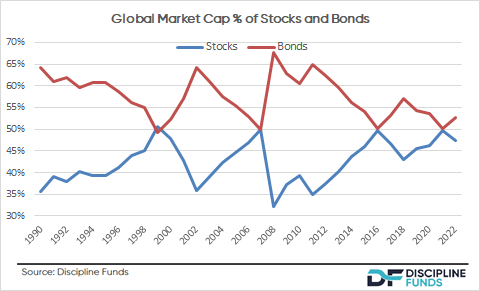In a 2018 interview John Bogle discussed how he managed his personal portfolio using a countercyclical rebalancing approach. When stocks were overvalued in 2000 he rebalanced his portfolio from 70/30 stocks/bonds to 25/75 stocks/bonds and when the markets corrected he rebalanced the other direction. He explained how this helped him remain fully invested by maintaining a more behaviorally robust asset allocation. It makes sense when you think about it – if stocks are grossly overvalued relative to bonds then why would a multi-asset index fund maintain an overweight position in stocks?
We founded the concept of Countercyclical Indexing to replicate Bogle's thinking by building a highly diverse, low fee, tax efficient and behaviorally robust asset allocation that just makes sense.
How Does It Work?
A standard indexing strategy such as a 60/40 stock/bond portfolio has many wonderful characteristics. It's diverse, low fee and tax efficient. The financial industry refers to this portfolio as a "balanced index", but the reality is that this portfolio is not very balanced at all. The reason a 60/40 portfolio cannot be reasonably called "balanced" is because it generates ~85%+ of its risk from the 60% slice thereby resulting in an unbalanced risk profile overall. Rebalancing this portfolio back to 60% stocks reduces the procyclicality of the portfolio, but still exposes the investor to very unbalanced risks over time. For instance, a 60/40 portfolio fell 31% during the 2008 financial crisis almost entirely because its 60% stock market slice declined by 51%. In other words, most of the risk in this portfolio came from the much more volatile stock component.
Rebalancing back to a fixed weight allocation makes very little sense because the actual size of the stock/bond markets is highly dynamic across time and you are often rebalancing back to a much riskier stock market weight. But if you were to follow an "efficient market" approach you would consistently be rebalancing more to stocks when they boom and less to stocks when they bust. This also doesn't make any sense. Over the period from 1990-2022 rebalancing in a countercyclical manner generated an annual return of 8.1% per year versus 6.7% in the market cap portfolio. In other words, by inverting the market cap of stocks vs bonds you improved your nominal AND risk adjusted returns.
Most importantly, what this does is better align an indexer's profile with their exposure to various asset classes over the course of the market cycle because you're essentially reducing risk to permanent loss as stocks become riskier and you're increasing your exposure to stocks as they become less risky (when they decline in relative value). This is important since the main factor in investment performance is not stock picking or market timing, but your own behavior.
Countercyclical Indexing creates a plan that systematically rebalances a portfolio so that you're always rebalancing against your behavioral biases thereby helping you remain fully invested and disciplined. This helps keep the investor more comfortable through thick and thin. And the beauty is, you can do this in a highly tax and fee efficient manner if you have the patience to actually let the approach play out over time.
Why Countercyclical Indexing Works
- The strategy magnifies William Bernstein's "rebalancing bonus" by rebalancing in a manner that is more consistent with the GFAP.
- The strategy takes advantage of Ray Dalio's "risk parity" concept by creating better parity between the risks of stocks and bonds in a portfolio.
- It can be low fee, tax efficient and just as passive as other traditional indexing strategies.
- When used in a core/satellite approach a Countercyclical Indexing strategy improves overall tax efficiency by inverting the core/satellite thereby giving the investor the ability to reduce the amount of capital gains paid over time by rebalancing INSIDE the countercyclical holding.
- The strategy optimizes for behavioral alpha instead of market alpha thereby creating a portfolio you're more likely to stick with even in tough times.


